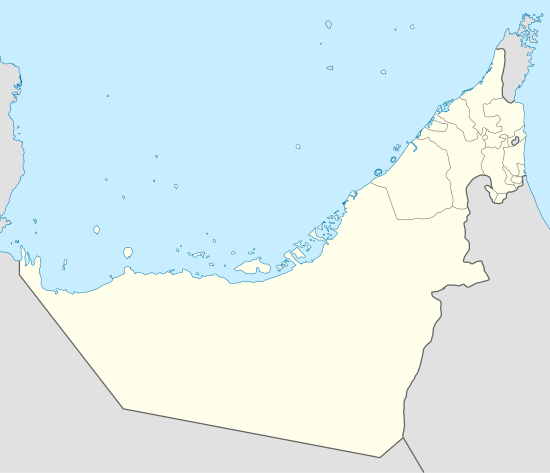Al Jazirah Al Hamra
| Al Jazirah Al Hamra | |
|---|---|
 Al Jazirah Al Hamra | |
| Coordinates: 25°42′32″N 55°47′50″E / 25.70889°N 55.79722°ECoordinates: 25°42′32″N 55°47′50″E / 25.70889°N 55.79722°E | |
| Country | United Arab Emirates |
| Emirate | Ras Al Khaimah |
| Elevation | 8 m (29 ft) |
Al Jazirah Al Hamra is a town to the south of the city of Ras Al Khaimah in the United Arab Emirates. It is known for its collection of abandoned houses and other buildings, including a mosque, which are widely believed locally to be haunted.[1][2][3] The town was ruled by the Al-Zaab tribe, which was rehoused in Abu Dhabi following a dispute with the Ruler of Ras Al Khaimah.
History
The town was originally a tidal island and, by 1830, was home to some 200 people mostly occupied in pearl fishing. At the time, it was a dependency of Sharjah.[4]
The Sheikh of Jazira Al Hamra in 1820, Rajib bin Ahmed, was a signatory to the original 1820 treaty between the Trucial States and the British. In the treaty, the sheikhdom was named as 'Jourat Al Kamra'. The town has also been called Jazirah Al Zaab.
Following an agreement between Khaled bin Ahmad of Sharjah and Sultan bin Salim of Ras Al Khaimah in 1914, the town became part of Ras Al Khaimah, but was often in dispute with the Ruler.[5] This led, in 1968, to a dispute with Sheikh Saqr of Ras Al Khaimah which resulted in the majority of the tribe accepting an offer from Sheikh Zayed bin Sultan to move to Abu Dhabi. This movement left behind an almost completely abandoned village which had housed some 2,500 people.[6]
Zaabi
The last Al-Zaab Sharif (mayor) of Jazirah Al Hamra was Hussein Bin Rahma Al-Zaabi, who was later the Sharif of Al-Zaab area in Abu Dhabi. His eldest son Rahma is the United Arab Emirates ambassador to Kuwait.
References
![]()
- ↑ Zacharias, Anna (27 November 2014). "Our guide to the living ghost town Jazirat Al Hamra, Ras Al Khaimah". The National. Retrieved 30 October 2015.
- ↑ Nair, Rohit (30 October 2015). "Dubai residents recount their scariest moments". Khaleej Times. Retrieved 30 October 2015.
- ↑ Sengupta, Abhishek (28 October 2015). "Revealed: UAE's most 'haunted' places". Gulf News. Archived from the original on 30 October 2015. Retrieved 30 October 2015.
- ↑ Schofield, R (1990). Islands and Maritime Boundaries of the Gulf 1798–1960. EK: Archive Editions. p. 542. ISBN 978-1-85207-275-9.
- ↑ 1941-, Heard-Bey, Frauke, (2005). From Trucial States to United Arab Emirates : a society in transition. London: Motivate. pp. 87–88. ISBN 1860631673. OCLC 64689681.
- ↑ 1941-, Heard-Bey, Frauke, (2005). From Trucial States to United Arab Emirates : a society in transition. London: Motivate. p. 75. ISBN 1860631673. OCLC 64689681.
